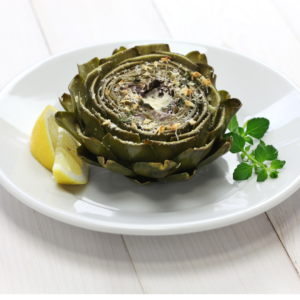Day 12
Artichokes
It’s the official vegetable of our great state. It packs a punch in the nutrition department. Its taste is mild and agreeable, slightly nutty (some call that “earthy”) and to me, I taste subtle floral notes when it meets my tongue. And the best way to eat it proves to be a fun table pursuit that even kids find kind of entertaining!
Activity – Artichoke eating
 So, as I considered writing about one of my favorite Friday night meals – cleanse or not – artichokes topped the list. In our house, we have artichokes a few ways: sliced in half, dress up the open face with drizzled olive oil, balsamic vinegar, spices and sometimes parmesan cheese (non-cleanse days) then baked/broiled; cutting out the hearts (or buying them frozen or jarred), then adding them to a salad; or, my favorite way, steamed whole.
So, as I considered writing about one of my favorite Friday night meals – cleanse or not – artichokes topped the list. In our house, we have artichokes a few ways: sliced in half, dress up the open face with drizzled olive oil, balsamic vinegar, spices and sometimes parmesan cheese (non-cleanse days) then baked/broiled; cutting out the hearts (or buying them frozen or jarred), then adding them to a salad; or, my favorite way, steamed whole.
The third option – steaming them whole – after they’re cooked, each is served in an individual bowl. When the meal begins, start by plucking the petals off its globe, making a pit stop at a ramekin of an olive oil (and non-cleanse, a small pat of butter) and a spiced lemon blend. Then, with your bottom teeth, scrape the meat off of the inner part of each petal. This initiates the built-in mealtime fun of eating steamed artichokes. My kids were introduced to this artichoke “activity” at a very young age. Even if they didn’t love artichokes, the activity aspect of eating them made it an enjoyable event and a healthy meal, since artichokes are loaded with vitamins and minerals!
spiced lemon blend. Then, with your bottom teeth, scrape the meat off of the inner part of each petal. This initiates the built-in mealtime fun of eating steamed artichokes. My kids were introduced to this artichoke “activity” at a very young age. Even if they didn’t love artichokes, the activity aspect of eating them made it an enjoyable event and a healthy meal, since artichokes are loaded with vitamins and minerals!
Once you’ve worked your way around the outer petals – plucked, dipped and scraped – next you’ll discover the inner petals – slightly translucent, with the outermost layer that’s slightly sweet. These petals are often surprisingly completely edible. The innermost, inner petals taste bitter, have longer thorns, and the only edible part is the fleshy base, that when plucked in unison at the tops of their thorny crown, are that same vaguely sweet flavor of the first layer.
At this point, you’ve reached the hairy base, or top of the inner globe (the top of its heart). Here, you’ll use a simple butter knife to continue the artichoke deconstruction process. Cut around the circular, outer edge about a half-inch to an inch deep, cut through the edge in a clockwise movement to dislodge the hairy, spindly tufts from the artichoke’s core.
At last, you’ve reached your destination – the artichoke heart! If done correctly, you’ve got a beautiful prize for all your hard work sitting in your bowl waiting to reward you with its pleasant texture and taste. Slice it in manageable cubes; drizzle or soak, with the remaining ramekin of olive oil; sprinkle with a little sea salt. Put a fork in, one morsel at a time, and enjoy. My kids think I’m crazy, but whenever I savor the bounty of this mealtime artichoke adventure, I’m always reminded of a potato. The dusty green color looks nothing like one, but the texture and olive oil goodness it absorbs all remind me of the innards of a spud.
 What is it?
What is it?
So what exactly is this picturesque plant that Californians love to eat? As we just uncovered, artichokes contain a hidden flower within each globe called the “heart.” The activity of eating artichokes begins with plucking the thorn-tipped petals that are the layered fortress walls encasing and protecting the heart. If left in nature, undisrupted, an artichoke’s flower at its core (its heart) will blossom into a beautiful lilac-or-lavender-colored, spindly flower.
I see the wild versions or artichokes and their flowers on my runs through the mountain trails here in SoCal. They’re quite beautiful. As Britannica explains, artichokes were first brought to the US from France to Louisiana in the early 1800s and then the Italians brought the exotic-looking plant to California from Italy in the early 1900s. Artichokes are part of the thistle family originating in North Africa. In ancient times, the Moors migrated with them to Mediterranean countries. Because our central California and SoCal climates are similar, artichokes flourish in our state.
Nutrients
According to Britannica, artichokes are a rich source of potassium, vitamin C, and dietary fiber. The California Artichoke Advisory Board, notes that [according to the] “United States Department of Agriculture, artichokes rank as the number one vegetable in antioxidant count.” That makes it a superior cleanse vegetable and an unmatched superfood that takes the number one vegetable spot on my cleanse for more than just one reason!
Cleanse Day 12 2024 – Artichokes
María Felicia’s 2023 New Year Body… Cleanse – Day 12

Written by Maria Felicia Kelley
Disclaimer: Maria Felicia Kelley is not a medical doctor. The cleanse and fasting benefits she discusses in this post are derived from her own experiences and observations. Individuals should consult their own healthcare providers when eliminating foods from their diets.
@thenorthcountymoms | @1MariaFelicia
The North County Moms


